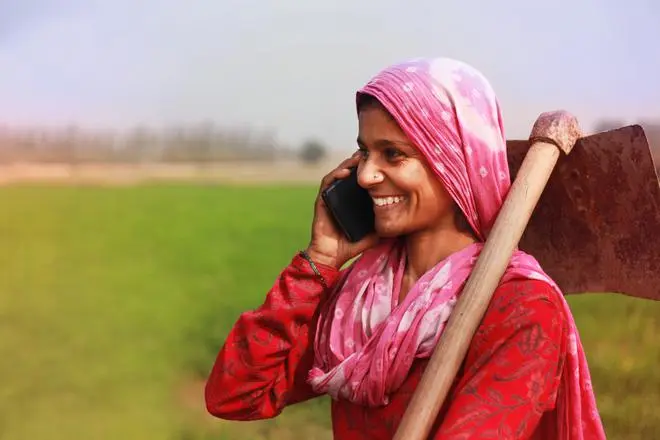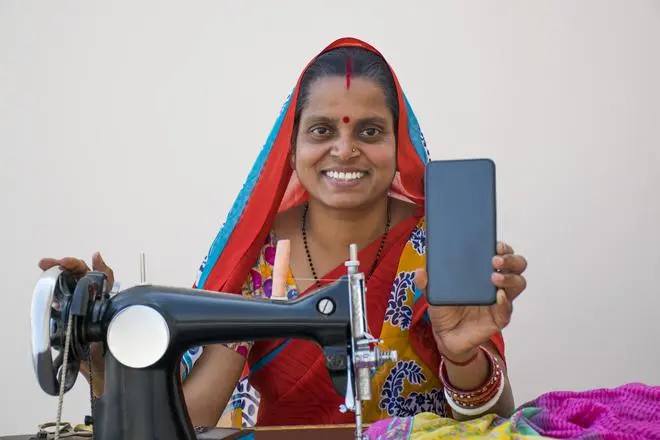Kamla says she turned from helper to co-owner in her husband’s grocery shop the day he handed over his smartphone to her. That day, like every other, he had kept shop till Kamla joined him after completing her morning household chores, then he had left to work on their farm. But unlike other days, recalls Kamla, he had not taken his smartphone with him. A small gesture that sowed the seeds of Kamla’s empowerment. Since then, Kamla has found several ways of adding to their shop’s efficiency by using the smartphone. “My wife has got into many Whatsapp groups, she lists our products and prices in them, takes orders on phone, finds and purchases cheap bargains and new products online to sell at profit,” preens Kamla’s proud husband.
Kamla is one among 838 women who learnt to use the smartphone in a digital literacy programme held in 16 villages in Uttar Pradesh’s (UP) Lalitpur district. The average age of the women participants was 32 years. Titled TARA WE ADD, the programme was implemented by civil society organisation Development Alternatives earlier this year.
A study of the programme’s impact by research organisation India Development Foundation (IDF) released in September 2022 finds a sturdy link between women learning digital skills and a growth in their incomes and livelihood opportunities. Sixty-two and 59 per cent of the women participants surveyed for the study, in fact, say they are now using the smartphone and internet ‘to increase and promote (my/my family’s) business’ and ‘to learn new ways of earning money’ respectively.

The study’s findings are significant given India’s female work participation rate at 25 per cent in 2020-21, as per the Periodic Labour Force Survey annual report, is among the lowest for emerging economies.
A network of growth
It is perhaps even more consequential because a glaring digital divide between men and women persists even as internet access in India, especially via mobile, is growing. The National Family Health Survey-5 2019-2021 reports only one in three women in India have ever used the internet, compared to more than half our men. The gap is even larger in rural India, with men being about twice as likely as women to have used the internet, at 49 per cent against 25 per cent respectively. Though women’s mobile phone access is higher than their internet access, it is only 54 per cent. In some states, including UP, it is less than 50 per cent.
The digital literacy programme for women in UP’s villages is therefore remarkable for having operated in, and against, this acute gendered digital deprivation. And for focusing its efforts at enabling women to enhance incomes and find livelihood by using the digital medium. The programme comprised three parts: initial community mobilisation, digital literacy training over 24 days, and finally, for interested participants, a choice of vocational tutorials with an emphasis on using digital technology.

IDF’s study assesses the combined outcomes of all these parts by using quantitative and qualitative research methods. Ten per cent of the total women trained were sampled and surveyed twice, before and after the training. Then, for an in-depth understanding of the survey results, focus group discussions and interviews were conducted with women participants, their family members, community leaders and field staff.
A bridge to the economic mainstream
The study presents evidence that acquisition of digital skills changes women’s perception of the role digital technology can play in optimising their income-generation. The survey respondents were asked ‘why women should possess mobile phones’. Sixty four, 47 and 33 per cent answered ‘for work purposes’, ‘finding employment’ and ‘doing business and job’ respectively. The corresponding figures before the respondents had undergone the training had been a meagre 13, zero and zero per cent. Following a similar trend, when asked ‘how learning to use a mobile phone and the internet can help you’, 64 per cent women answered ‘to learn new ways of generating income’. Only 44 per cent had said so before undergoing the training.
Furthermore, as a tangible validation of the economic gains that using digital technology makes possible for women, the study reports a rise in the programme participants’ incomes. These increases are calculated using the participants’ incomes as recorded by the programme’s field staff through tracking the former’s sales registers, or conducting interviews with them. Incomes of women who run petty businesses, either independently or family-owned, are seen as having increased by 16 per cent on average within three months of the training’s completion. Incomes of women enabled into setting up small home-based enterprises by the programme’s vocational trainings are also seen to have grown by 27 per cent in the same period.
The study’s qualitative findings provide further substantiation of the link between women’s attainment of digital skills and their improved work practices and prospects.
“Some customers at our grocery store would buy on credit earlier, claiming they had no cash. Now I tell them to pay me via Phonepe,” declares Bimla, a programme participant. Several other participants, who run petty businesses like Bimla, say they too have got QR scan codes issued to receive payments. Seema, a home-based tailor, says she now charges more for the blouses she stitches because she has learnt to make new designs from tutorial videos on Youtube. Another participant, Sarla, has enrolled as a Vidyut Sakhi under the National Rural Livelihood Mission scheme. She now assists people with paying their electricity bills online and makes INR 20 per bill paid.
Women from farmer-families say after attending the training they have started online searches, mostly voice searches, for information related to crop prices, crop insurance, loans and schemes for farmers. “Entire families are engaged in farming here, it is the main income for most of us,” elaborates programme participant Ritu, adding: “Today I know how to find and learn from the thousands of advisory videos on agriculture available on Youtube.” Some other participants say they now know that there are apps to track weather conditions, test soil quality and crop health. And as they get more familiar with using smartphones, they will eventually start using these.
Women unengaged in income-generating work, meanwhile, speak of having launched new enterprises post-training, and of the smartphone’s critical role in setting-up and running them.
On an equal footing
Sujata, who underwent the programme’s vocational training in vermicompost manufacture, says she ordered a vermicompost bed from shopping portal Amazon to start her venture. “Also, I announced that the compost will soon be ready for sale in my village Whatsapp business group,” she adds. Karuna began taking on “small beauty and bridal make-up jobs” after attending the programme’s beautician training, and she has earned about Rs. 5000 already. Most of her bookings are made via smartphone, she buys products online, learns new beauty-care and make-up techniques on Youtube, and uploads sample pictures of her work in different Whatsapp groups. “We are in the process of setting-up a basic beauty parlour at home,” informs Karuna’s husband, “The smartphone is a necessary business tool for us.” Anita has started a small readymade garments shop post the training. She purchases garments online at bargain prices, and sells them for a profit in her village.
Sarla, schooled up to class 12, says she is going to put her digital literacy training to use by searching for local jobs online: “Like sales positions at malls in the Lalitpur town. Smartphones make job searches in the neighbourhood possible.”
The programme’s digital literacy instructors say the training’s topmost gain has been making women aware that social media groups can be local platforms for selling their wares and services, as also for finding local employment. Presently the field staff have created 16 Whatsapp business groups for the digitally-trained women, one for each programme village. Women have started posting information and images of their products and services in these. An instructor shares: “Enquiries in these groups reassure women that there are potential customers for their businesses. This is extraordinary, and encouraging, for women who till recently did not know whom to sell their products and services to.”
Most crucially perhaps, witnessing the positive economic outcomes that digital literacy can affect has altered perceptions about women using digital technology for of many in the community — including for women themselves. Before they underwent the training, recollect women and their family members, they thought smartphones distract from housework and performing family duties, and can expose women to unsafe male contact. But these apprehensions and fears stand allayed now. Having experienced the use of digital devices firsthand has convinced them that smartphones are essential to modern living, and to women’s safety, self-reliance and earning capacities.
“Most families in villages have mobiles nowadays, many have smartphones. But women can’t use them, don’t feel the need to. They do housework, need to speak only to children and relatives, and do so on their husbands’ phones,” the sarpanch of a programme village says, and argues: “Women will use smartphones only if they start working to earn.” Perhaps also, women will start earning once they start using smartphones.
Names have been changed to protect the privacy of study subjects.
The author is Fellow, India Development Foundation (IDF).








Comments
Comments have to be in English, and in full sentences. They cannot be abusive or personal. Please abide by our community guidelines for posting your comments.
We have migrated to a new commenting platform. If you are already a registered user of TheHindu Businessline and logged in, you may continue to engage with our articles. If you do not have an account please register and login to post comments. Users can access their older comments by logging into their accounts on Vuukle.